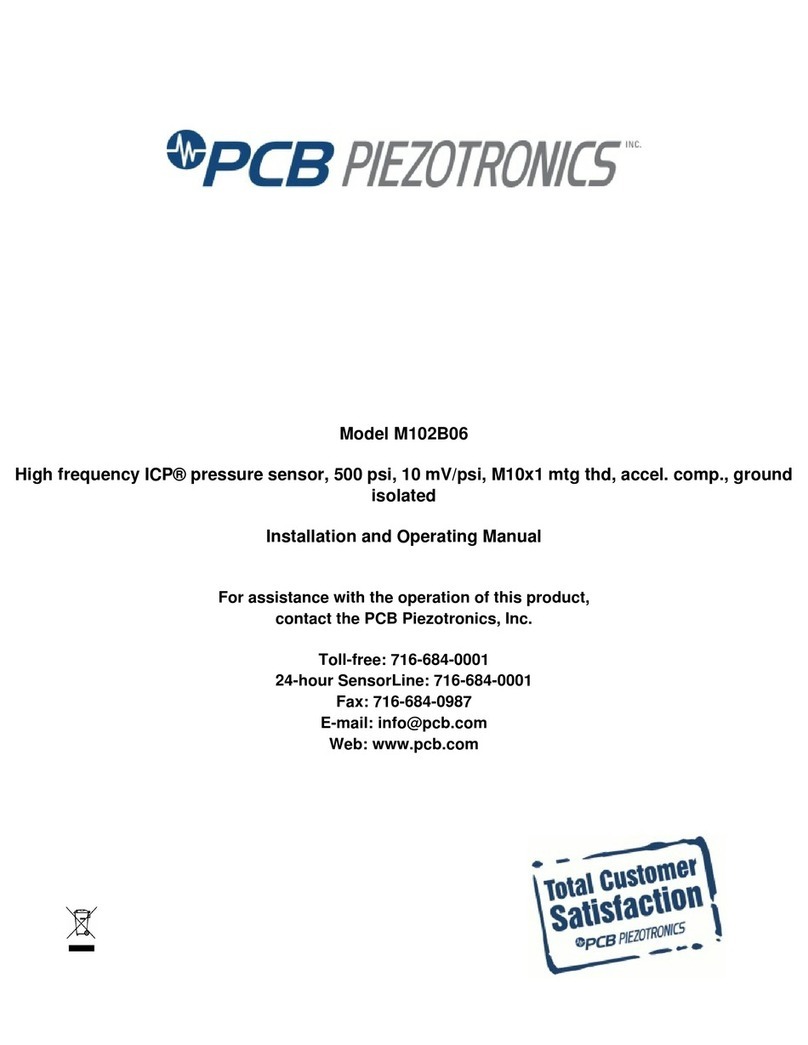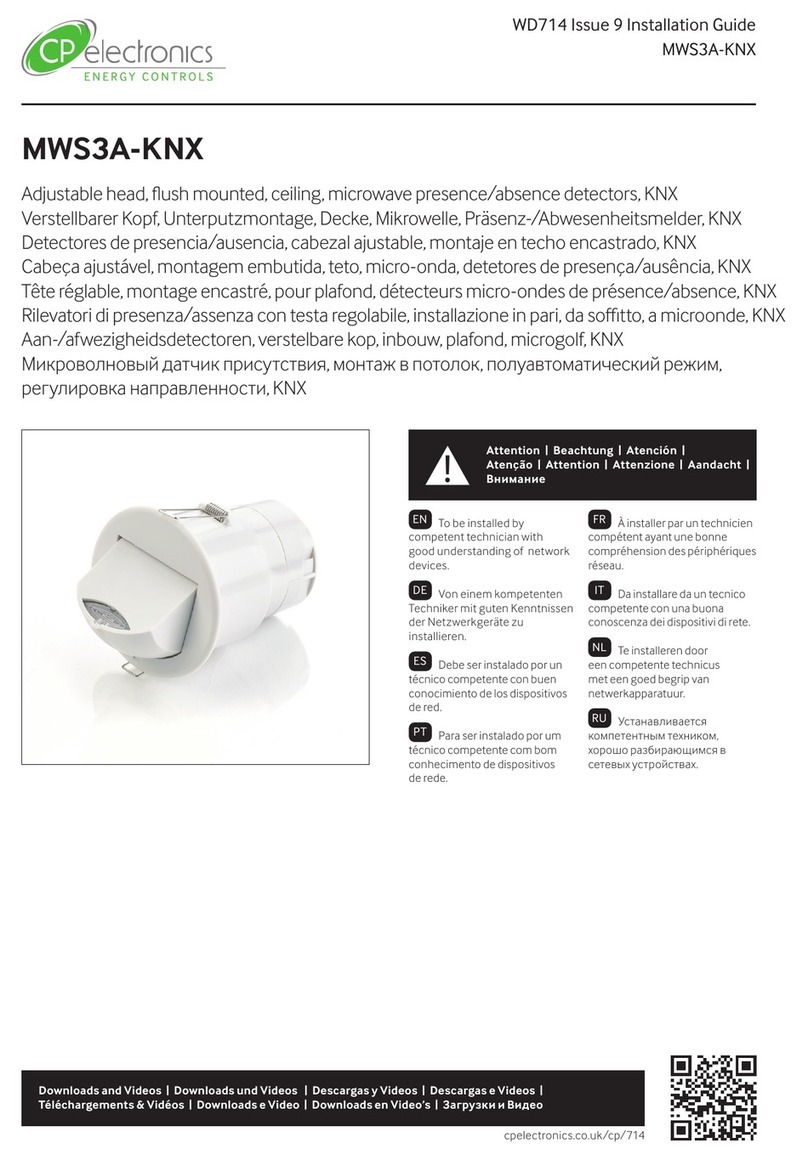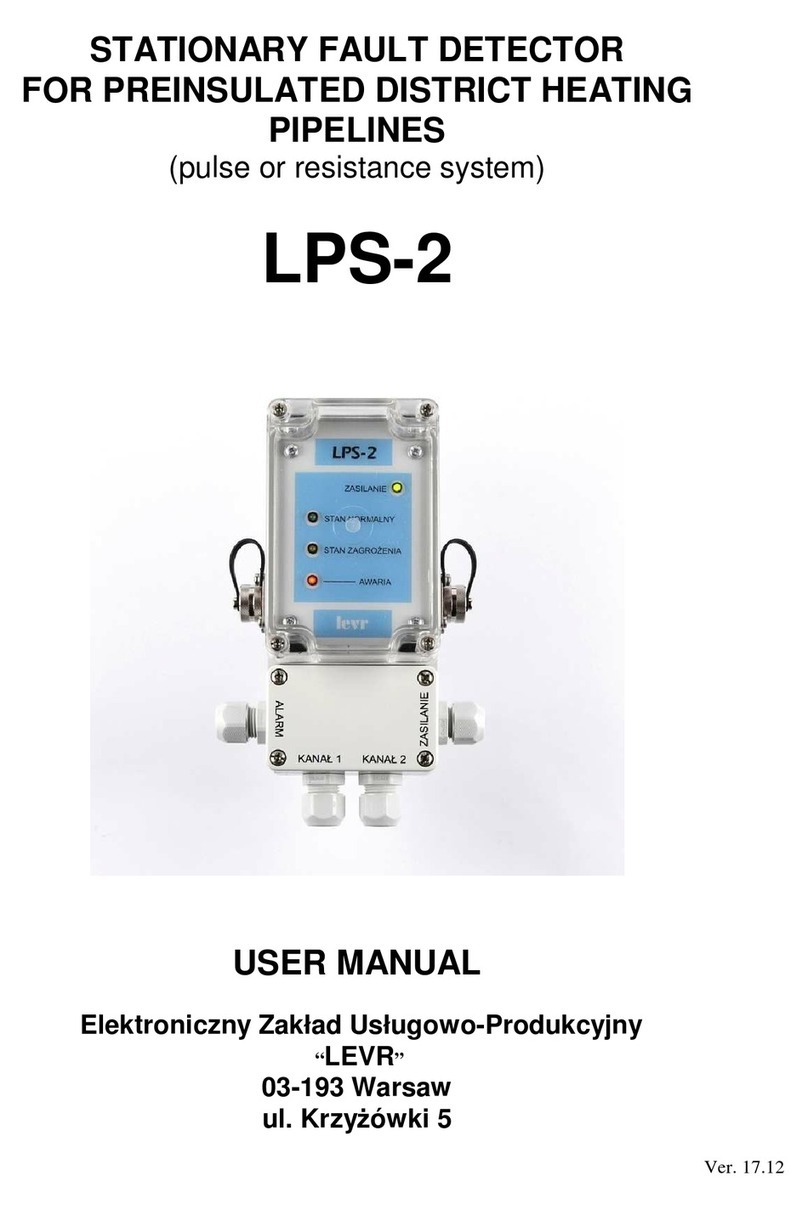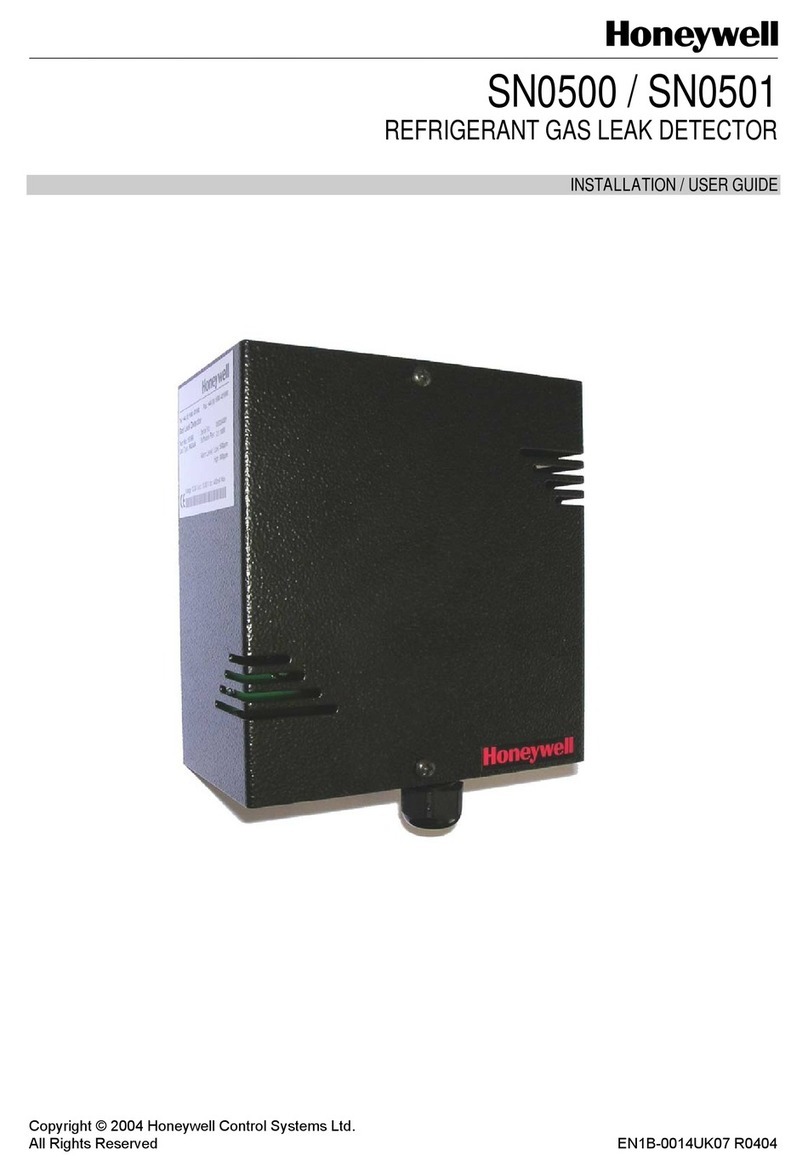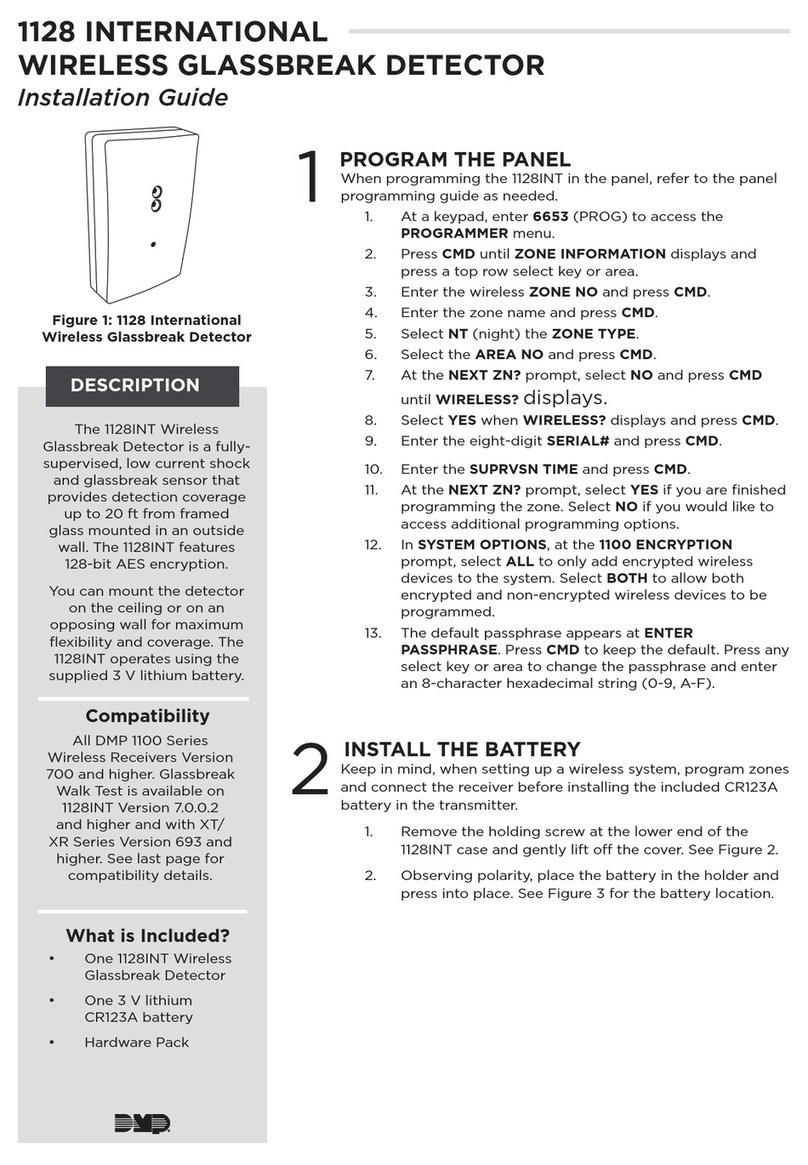SPECS 2D-CCD User manual

User Manual | Status 10.12.2015 | Version 1.0
User Manual V1.0 | October 19, 2015

1
User Manual | Status 10.12.2015 | Version 1.0
SPECS Surface Nano nalysis GmbH
Voltastrasse 5
13355 Berlin
Germany
Tel: +49 30 46 78 24-0
Fax: +49 30 46 42 08-3
Email: [email protected]
Web: http://www.specs.com
SPECS User Manual
2D-CCD / 3D-VLEED Detector, Version 1.0
October 16, 2015
SPECS order number reference: 2100000201
©2015. ll rights reserved. No part of this manual may be reproduced without the prior
permission of SPECS GmbH. Other product and company names mentioned in this
document may be the trademarks or registered trademarks of their respective owners and
are used for identification purposes only.

2
User Manual | Status 10.12.2015 | Version 1.0
Table of contents
1
Introduction ....................................................................................................................... 5
bout .................................................................................................................................. 5
1.1
Information ........................................................................................................................ 5
1.2
Safety .................................................................................................................................. 6
1.3
2
Preliminary tasks ............................................................................................................... 7
Baking out .......................................................................................................................... 7
2.1
Vacuum conditions ............................................................................................................ 8
2.2
Electrical connections ........................................................................................................ 8
2.3
2.3.1
Connecting the SPECS power supplies ............................................................................. 9
2.3.2
Connecting the Focus power supplies ............................................................................. 9
2.2
Degassing the Ferrum detector ...................................................................................... 11
2.3
Fitting the CCD camera.................................................................................................... 11
Fitting the alignment camera .......................................................................................... 11
2.4
Degassing the detector ................................................................................................... 11
2.5
2.4
Conditioning the spin detector ....................................................................................... 13
3
Operation ......................................................................................................................... 14
3.1
Using templates to set up experiments ......................................................................... 14
Templates for the 2D-CCD / 3D-VLEED detector ........................................................... 17
3.1
3.1.1
PHOIBOS 1D djustment ................................................................................................ 17
3.1.2
PHOIBOS 1D DVS ............................................................................................................. 17
3.1.3
Scattering Energy Scan .................................................................................................... 18
3.1.4
PHOIBOS Spin djustment ............................................................................................. 18
3.1.5
UPS Spin Step Profile ....................................................................................................... 19
Performing CCD measurements ..................................................................................... 19
3.2
Viewing results ................................................................................................................. 20
3.3
3.3.1
Calculating the spin asymmetry ..................................................................................... 20
Using the Image View to display results ........................................................................ 22
3.4
4
Troubleshooting............................................................................................................... 23
4.1
mplifier check ................................................................................................................ 23
4.2
Discriminator threshold .................................................................................................. 24
4.3
Noise ................................................................................................................................. 25
4.4
Checking the voltages ...................................................................................................... 25
4.1.1
Detector settings .............................................................................................................. 25
4.1.2
Voltages ............................................................................................................................ 26
4.1.3
Rotator .............................................................................................................................. 27
4.5
Capacitances .................................................................................................................... 27

3
User Manual | Status 10.12.2015 | Version 1.0
5
Spin Detector Principles .................................................................................................. 29
Electron optics ................................................................................................................. 29
5.1
5.1.1
nalyzer ............................................................................................................................ 30
5.1.2
cceleration lens ............................................................................................................. 30
5.1.3
Rotator lens ...................................................................................................................... 31
90° deflector .................................................................................................................... 32
5.2
5.2.1
Retardation stage ............................................................................................................ 33
3D spin polarization detection ....................................................................................... 33
5.3
Spin detector lens transmission ..................................................................................... 34
5.4
VLEED spin detector ........................................................................................................ 35
5.5
PCU 300 Electronics ......................................................................................................... 35
5.6
Example of experimental results .................................................................................... 35
5.7
6
Principles of the CCD Detector ....................................................................................... 42
Camera ............................................................................................................................. 42
6.1
Linearity ............................................................................................................................ 42
6.2
Dynamic range ................................................................................................................. 43
6.3
Flat field correction ......................................................................................................... 43
6.4
6.4.1
Bias frame or dark frame IB ........................................................................................... 44
6.4.2
Flat field frame IF ............................................................................................................. 44
6.4.3
Non-calibrated object exposure IR ................................................................................ 44
Full well capacity .............................................................................................................. 44
6.5
Hot pixels ......................................................................................................................... 45
6.6
Camera specifications ..................................................................................................... 46
6.7
Micro channel plates ....................................................................................................... 46
6.8
Care of MCPs .................................................................................................................... 46
6.9
Maximizing the lifetime of MCPs .................................................................................... 47
6.10
6.10.1
Storage ............................................................................................................................. 47
6.10.2
Operating voltage ............................................................................................................ 47
6.10.3
Bakeout ............................................................................................................................ 47
6.10.4
Degassing the detector ................................................................................................... 48
6.10.5
Measurements ................................................................................................................. 48
Handling MCPs ................................................................................................................. 48
6.11
Phosphor screen .............................................................................................................. 49
6.12
pplication data ............................................................................................................... 49
6.13
7
Power Supplies ................................................................................................................ 53
HS 3500plus Spin rear panel ........................................................................................ 53
7.1
7.1.1
Filter box connectors ....................................................................................................... 53
7.1.2
Rotator connector ............................................................................................................ 54
7.1.3
24 V switch ....................................................................................................................... 54
7.1.4
Interlock ........................................................................................................................... 54

4
User Manual | Status 10.12.2015 | Version 1.0
7.1.5
Other specifications......................................................................................................... 54
HS 3500plus Spin hardware type ................................................................................. 55
7.2
ppendix - Installation ................................................................................................................. 57
.1 Packing list ............................................................................................................................... 57
.2 ssembling the detector ........................................................................................................ 58
.2.1 Mounting the CCD/rotator/deflector part .......................................................................... 59
.2.2 Mounting the Ferrum detector part ................................................................................... 63
.3 Optimizing the signal .............................................................................................................. 66
.3.1 djusting the beam position of the electron gun.............................................................. 66
.3.2 djusting the deflector/rotator lens ................................................................................... 67
.3.3 djusting the beam alignment for the total intensity channel ........................................ 70
.3.4 djusting the beam alignment with the spin channel ...................................................... 70
.4 lignment with phosphor screens ......................................................................................... 71
.4.1 lignment of spin deflector 1 and the rotator lens with the alignment camera ............ 72
.4.2 lignment of spin deflector 2 with a phosphorous screen .............................................. 74
.5 Camera alignment .................................................................................................................. 75
.5.1 Rough angle adjustment ..................................................................................................... 75
.5.2 Setting the focus .................................................................................................................. 79
.5.3 Set X–Y .................................................................................................................................. 80
.5.4 Fine angle adjustment ......................................................................................................... 81

5
User Manual | Status 10.12.2015 | Version 1.0
1 Introduction
Welcome to the user manual for the SPECS 2D-CCD / 3D-VLEED Detector. This detector is suitable
for performing measurements in a wide range of spin-dependent studies.
This chapter explains briefly how to use the manual and points you toward further sources of
information.
Most importantly, it contains safety notices that you should read before operating the equipment.
About
1.1
The manual is divided into the following chapters:
1. Introduction
2. Preliminary tasks
3. Operation
4. Troubleshooting
5. Spin detector principles
6. Principles of the CCD Detector
7. Power supplies
There is also an ppendix that describes the initial installation of the detector. This is performed
by SPECS service personnel and is not a normal user task.
Information
1.2
The 2D-CCD / 3D-VLEED Detector is intended for use with PHOIBOS 150 and 225 electron energy
analyzers. Manuals describing the operation of the PHOIBOS analyzer and its power supplies are
available as separate documents. You should consult these manuals in addition to this document
in order to achieve safe and reliable operation.
Note that mounting the 2D-CCD / 3D-VLEED Detector imposes the following limitations to the
performance of the PHOIBOS analyzer:
• The maximum kinetic energy, E
kin
is 1500 eV.
• The maximum pass energy, E
p
, is 200 eV
• Ions cannot be detected
For further advice and assistance, please also contact SPECS support:
Tel. +49 30 46 78 24-0

6
User Manual | Status 10.12.2015 | Version 1.0
If you need to return this SPECS product for repair, service or upgrade, please first contact SPECS
support. We will provide you with an RM as well as details for correct packaging and shipment of
the instrument. This will ensure safe transportation and speedy processing.
Safety
1.3
The document "Safety Instructions" is contained with this instrument. This contains important
warnings and procedures that you should adopt when using SPECS equipment.
Danger—High Voltages Present!
Do not operate the instrument without cables correctly connected. Ensure that cables are not
worn or damaged. Only qualified personnel using appropriate equipment should perform repair
work.

7
Manual V2.docx | Status 10.12.2015 | Version 1
2 Preliminary tasks
Before using the detector, you need to perform standard procedures so that the detector is ready
for use.
Note
Initial installation and alignment is performed by SPECS engineers on delivery of the instrument.
These procedures are provided for reference in the ppendix of this manual.
This chapter describes the following:
• Bakeout.
• Suitable vacuum conditions for operation.
• Conditioning the Spin detector .
• Electrical connections.
• Fitting the camera for the CCD detector.
• Degassing the detector.
aking out
2.1
In order to achieve UHV, you need to bake out the chamber. Before baking out, you should ensure
the following:
• The chamber is leak-free with a pressure of 10
−7
mbar or lower.
• ll connection cables are removed.
• The cameras are removed.
Switch off any power supplies before removing cables.
The maximum bakeout temperature for the 2D-CCD / 3D-VLEED Detector is 150°C. You should
attach a thermocouple to the detector flange to monitor the temperature during bakeout.
Note
Remember to observe the maximum bakeout temperature for all other instruments on the
chamber!
fter baking out, the analyzer needs two days to cool down in order to protect the working
surfaces of the detector. The interior parts of the PHOIBOS will cool down significantly more
slowly than the casing. You should wait until the detector assembly has cooled down completely—
this takes approximately 2–3 days.
Caution!
Manual V2.docx | Status 10.12.2015 | Version 1

8
Manual V2.docx | Status 10.12.2015 | Version 1
Even if the analyzer casing just feels warm, any internal parts seated on insulators may still be too
hot for safe operation. ll users should be aware of this issue and take the necessary precautions.
Vacuum conditions
2.2
lways observe the following points in order to protect the detector:
• void backstreaming from oil diffusion pumps or roughing pumps at all costs. When
using such pumps, you should use cold traps and molecular sieve traps. Make sure these
are correctly maintained.
• Operate the detector in a clean vacuum environment of 5 × 10
−8
mbar or better in order
to ensure the longevity of the detecting surfaces. The detector can be degraded by
exposure to various types of hydrocarbon gases which raises the work function of the
surface and hence causes gain degradation.
• Do not allow gases containing F, S and Cl to enter the detector area, as they may
decompose under electron bombardment.
Caution!
Do not operate the detector without a vacuum interlock. If high voltage is applied to the detector
while the chamber vents, all CEMs and MCPs will be irreparably destroyed.
Electrical connections
2.3
The wiring scheme for the 2D-CCD / 3D-VLEED Detector is complex and involves several power
supplies. To make the wiring scheme easier to understand, it is divided into two parts, which are
described in the following sections.
Please note these general points for the electrical connections and power supplies:
• There is a ground screw on the rear of the power supplies which should be attached to a
central earthing point by a low resistance earthing strap.
• The power supplies should be fitted into a rack or installed on a flat, stable surface.
• Make sure the equipment is protected against high pressures by interlocks. Do not
defeat the interlocks during operation.
The 2D-CCD / 3D-VLEED Detector requires several power supplies for its operation:
• Two SPECS HS 3500plus units for the CCD detector and the rotator.
• Three Focus units for the spin detector, evaporator and coil magnetization.
The following figures show all electrical connections for the 2D-CCD / 3D-VLEED Detector.

9
Manual V2.docx | Status 10.12.2015 | Version 1
2.3.1 Connecting the SPECS power supplies
Figure 1 shows the connection diagram for the SPECS electronics. With the exception of the
detector output signals, all connections for the Ferrum detector are provided by power supplies
from Focus.
Note
Exactly one of the two HS 3500 plus units should have the 24 V switch set to on.
Figure 1. Connection of SPECS power supplies
2.3.2 Connecting the Focus power supplies
In addition to the SPECS power supplies, there are also three power supplies from Focus, which
are used for operating the spin detector and its accessories:
• Ferrum Spin Detector Control Unit — supplies the voltages for the Ferrum spin detector
L4E
Ref
Ferrum Spin
Detector Controller
Ref in
Slit in
Diode box

10
Manual V2.docx | Status 10.12.2015 | Version 1
• Evaporator Power Supply EVC 300 — Supplies the voltages for the iron evaporator used
to grow a new target film
• Magnetic Pulse Control Unit — Provides the coil currents used to change the
magnetization of the scattering crystal.
For more details about these power supplies, please see the Focus manuals. The diagram below
shows the wiring scheme for these supplies in the context of the SPECS 2D-CCD / 3D-VLEED
Detector.
Caution!
Make sure the connectors on the rear of the spin controller power supply are all fitted to the
correct outputs. The cables and connectors are all labeled. Incorrect connections will lead to
unexpected behavior and can under certain circumstances damage the detector.
Figure 2. Connection of Focus power supplies
Ferrum Spin detector
control unit
Magnetic Pulse
Control Unit
Coil
EVC 300
Fil./T.C. HV
RS 232 USB
Flux in Shield
Oxygen Lens
Slit in
Ref in
Flux amplifier To PC
HS 3500 plus Spin
To PC
CH HV

11
Manual V2.docx | Status 10.12.2015 | Version 1
2.2 Degassing the Ferrum detector
Degas the evaporator and the scattering crystal as described in the Focus Ferrum Detector
manual.
2.3 Fitting the CCD camera
The CCD camera is mounted in a camera holder that clips onto the viewport on the detector. The
camera is aligned at the factory before installation, and only small adjustments need to be
performed. "Camera lignment" in the ppendix describes the complete alignment procedure,
including how to perform any fine adjustments that may be necessary.
Fitting the alignment camera
2.4
The alignment camera is mounted in a camera holder that clips onto the viewport on the
base flange of the CCD/deflector/rotator part.
Degassing the detector
2.5
For degassing the electron multiplier in the spin detector, please refer to the Focus Ferrum Spin
Detector manual. The following describes the procedure for degassing the CCD detector.
The CCD detector contains micro-channel plates (MCPs) that need to be slowly ramped up to their
operating voltages. You can do this with SpecsLab Prodigy. This procedure should be performed
after you have vented and baked the detector.
Caution!
If there are sudden flashes with unexpected structures, there may be a malfunction. In this case,
abort the degas procedure and contact SPECS service.
Caution!
The MCP will be damaged by excessive voltage.
See the test report for the maximum allowable voltage on the MCP (Udet)!
Note
During the first few days of operation of a new detector, it is recommended that high output
currents are avoided (i.e. inputs above 1 Mcps). Taking this initial burn-in precaution can prevent
premature failure.
To degas the detector:

12
Manual V2.docx | Status 10.12.2015 | Version 1
1. Switch on an X−ray or UV source so that it illuminates the sample. The sample should be
positioned so that electrons can pass through the analyzer and strike the detector.
2. Start SpecsLab Prodigy.
3. Open the Device Control (normally a tab shared with the Experiment Editor; otherwise
select it from the Views menu).
4. Click Connect at the PHOIBOS CCD device and wait for SpecsLab Prodigy to establish a
connection with the detector.
5. Expand the PHOIBOS CCD device and select the
Calib. Voltages
tab.
6. Open the Live Image View to observe the output from the camera during degassing:
• Select
Views/ Live Image View
from the menu bar.
• Click
ctivate
in the PHOIBOS CCD device control.
• Start the Live Image View. It will show the signal from the camera. This should be
blank at the moment.
Note
You can drag the bars below and to the right of the image pane to show the X and Y profiles of the
image. See the Online Help for more information about using the Live Image View.
7. Set the following:
• Ramp Time: 600 s.
• Screen Voltage: 1000 V.
8. Click
Ramp
. The screen voltage will be ramped up to the set value over ten minutes.
Figure . Ramping voltages

13
Manual V2.docx | Status 10.12.2015 | Version 1
9. Set the voltages according to the values in Table 1 (the first line has already been
completed in the previous steps).
Table 1. Ramping up detector values
Ramp time
(s)
Udet actual
(V)
Udet target
(V)
Uscrn actual
(V)
Uscrn target
(V)
600 0 0 0 1000
1800 0 1000 1000 0
4000 1000 1000 0 2000
4000 1000 1500 2000 2500
2.4 Conditioning the spin detector
Following the bakeout, you need to prepare a fresh iron film on the tungsten substrate in the
detector. This procedure is described in the Focus Ferrum Spin Detector manual — please see
"Preparing of the Fe film on the W(100) crystal" in the Operation chapter.

14
Manual V2.docx | Status 10.12.2015 | Version 1
Operation
If you are not familiar with the 2D-CCD / 3D-VLEED detector, it is recommended that you
read Chapter 5, “
Spin detector principles
” before continuing.
The 2D–CCD / 3D-VLEED Detector effectively consists of three detectors in one:
1. CCD detector capable of measuring spatial and dispersive dimensions.
2. VLEED Spin detector capable of measuring 3D spin polarization.
3. single channel detector capable of measuring the total intensity reaching the
VLEED spin detector.
In SpecsLab Prodigy, the PHOIBOS analyzer together with each one of the detectors is
available as an analyzer. Thus, there are three analyzers:
1. PHOIBOS CCD. With CCD detector.
4. PHOIBOS Spin. With VLEED spin detector
5. PHOIBOS 1D. With VLEED total intensity detector.
Switching between one operation mode and the other is simply a matter of selecting the
analyzer in the software.
Note
Before taking measurements, you need to be sure that SpecsLab Prodigy is correctly
configured to use your excitation source, e.g. by configuring an X-ray dummy source. Further
details are provided in the PHOIBOS and SpecsLab Prodigy manuals.
In addition to describing normal operating procedures for the detector in spin and CCD
modes, this chapter also describes the procedure for finding the optimum detector voltage
for the Ferrum detector.
3.1 Using templates to set up experiments
SpecsLab prodigy offers templates, pre-defined experiments or fragments of experiments,
which you can use to save common tasks. number of templates are included with the 2D-
CCD / 3D–VLEED Detector. The following sections describe the purpose of each of the
templates and their contents.
The procedure below shows the basic procedure for using templates. See also the SpecsLab
Prodigy Quick Guide and Online Help for more information.
Manual V2.docx | Status 10.12.2015 | Version 1

15
Manual V2.docx | Status 10.12.2015 | Version 1
To run an experiment with a template:
1. Switch on the power supplies.
6. Start SpecsLab Prodigy.
7. In the Experiment Editor, Click a template in the Load Template section. The
following example shows the UPS Spin Step Profile template.
Figure 4. Selecting a template.
8. Most of the settings in the template do not need to be changed before you start
the scan. You can however view the settings for each part of the scan by clicking
the tools icon.
Figure 5. Viewing settings
9. Change the settings for the spectrum group as necessary.

16
Manual V2.docx | Status 10.12.2015 | Version 1
Figure 6. Changing the spectrum group settings.
10. Click the button to start the scan.
If you make changes to a template and want to use these in future, you can save your
experiment as a template:
Click the icon in the top section of the experiment (just below the Description field) and
select
Save s
Template. dialog will open so that you can give the template a suitable
name. The template will appear in the main screen when you start SpecsLab Prodigy.
Figure 7. Saving an experiment as a template
You can also save other parts of the experiment as templates as part of a personal toolkit for
defining experiments. Please see the SpecsLab Prodigy Online Help for more information
about templates and the features available in the software.

17
Manual V2.docx | Status 10.12.2015 | Version 1
Templates for the 2D-CCD / 3D-VLEED detector
3.1
This section contains an overview of the templates delivered with the 2D-CCD / 3D-VLEED
detector.
3.1.1 PHOIBOS 1D djustment
The PHOIBOS 1D adjustment template is used for optimizing the detector signal using the
total intensity channel of the Ferrum detector. When you run this template, the analyzer
continually measures the intensity of electrons with a fixed energy. The signal is recorded by
the single channel detector without measuring any spin-resolved signal.
Note
This template is essentially identical to the PHOIBOS Spin djustment template, except that
the Spin Detector Control is set to Channel 1.
3.1.2 PHOIBOS 1D DVS
The optimum operating voltages for the CEMs of the Ferrum detector are determined by
SPECS during testing and are included in the test report. s the detector ages, the gain is
reduced and you need to increase the detector voltage to compensate. See the Focus Ferrum
spin detector manual for more information about life time and ageing of the CEMs.
Caution!
Do not set the detector voltage too high. The lifetime of the CEMs is significantly reduced at
high operating voltages. The optimum operating point is about 50–100 V beyond the plateau
of the intensity versus detector voltage sweep.
Caution!
The intensity of the excitation source needs to be much higher in the spin detector
compared to the CCD detector. lways turn the intensity of the source down before using
the CCD detector.
To check the detector voltage:
Transfer a clean sample into your system and place it in the measurement position in front
of the analyzer.
2. Switch on the excitation source.
3. Perform a quick scan to make sure that everything is working correctly. In
particular, you should confirm that the intensity of the source is not too high (this
is particularly important for electron sources).
4. Click to start a new project in the Experiment Editor.
5. Click PHOIBOS 1D DVS in the Load Template section.
6. Click to start the scan.

18
Manual V2.docx | Status 10.12.2015 | Version 1
See "Using the Image View to Display Results" on in Section 3.4 for instructions on viewing
the data.
3.1.3 Scattering Energy Scan
Scattering Energy (SE) scan records the intensity of electrons scattered from the scattering
crystal as a function of the scattering energy, i.e., the energy the electrons have at the
surface of the scattering crystal. Recording a scattering energy scan is a good way to ensure
that the film is of good quality and suitable for spin resolved measurements. lso see the
Focus Ferrum Spin detector manual.
See "Using the Image View to Display Results" in Section 3.4 for instructions on viewing the
data.
The following sections describe the template in greater detail. It is useful to know the
function of the components in the schedule if you want to modify the template.
Devices
1. UV Dummy: Provides the operating parameters for the excitation source.
11. PHOIBOS Spin: Controls the analyzer. This includes the setting for the rotator (–1
or 1).
12. Magnetic Pulse Control: llows you to magnetize the target during the
experiment.
13. Spin Detector Control: Sets the parameters for the Ferrum spin detector.
Step Profile
This section changes the scattering energy by changing the lens voltages of the Ferrum
detector for each step. The values for the voltages are stored in a matrix. For each entry in
the step profile, the spectra defined in the spectrum group are measured.
Spectrum Group
This contains the definition for the spectrum(s) that you want to measure. In this case, the
intensity is measured for a fixed energy. In order to have sufficient statistics, 10
measurements are made.
3.1.4 PHOIBOS Spin djustment
The PHOIBOS Spin adjustment template is used for optimizing the detector for spin-resolved
signals. When you run this template, the analyzer continually measures the intensity of
electrons with a fixed energy.
Note

19
Manual V2.docx | Status 10.12.2015 | Version 1
This template is essentially identical to the PHOIBOS 1D djustment template, except that
the SpinDetector Control is set to Channel 2.
3.1.5 UPS Spin Step Profile
This temple is used to carry out actual measurements with the spin detector.
The following sections describe the template in greater detail. It is useful to know the
function of the components in the schedule if you want to modify the template.
Devices
The following devices are required:
• UV Dummy: Provides the operating parameters for the excitation source.
• PHOIBOS 1D: Controls the PHOIBOS analyzer. This includes the setting for the
rotator (–1 or 1).
• Magnetic Pulse Control: llows you to magnetize the target during the experiment.
• Spin Detector Control: Sets the parameters for the Ferrum spin detector.
Sleep
When you start the experiment, the devices are initialized. In particular, charging the
magnetic pulse controller and magnetizing the target takes some time. The sleep item makes
SpecsLab Prodigy wait before going on to the next step.
Step Profile
For each entry in the step profile, the magnetization of the sample is changed before the
spectra defined in the spectrum group are measured. The setting in the template contains
eight iterations, which are sufficient to obtain results which are not affected with time drift.
lso see the Focus Ferrum Spin detector manual.
Sleep
The second sleep item gives the system time to magnetize the target.
Spectrum Group
Defines the spectrum. See the SpecsLab Prodigy manual.
Performing CCD measurements
3.2
Taking data with the CCD detector follows the standard procedure described in
SpecsLab Prodigy Quick Guide and Online Help. Please see this documentation for an
example of how to set up a spectrum and measure data.
This manual suits for next models
1
Table of contents
Popular Security Sensor manuals by other brands
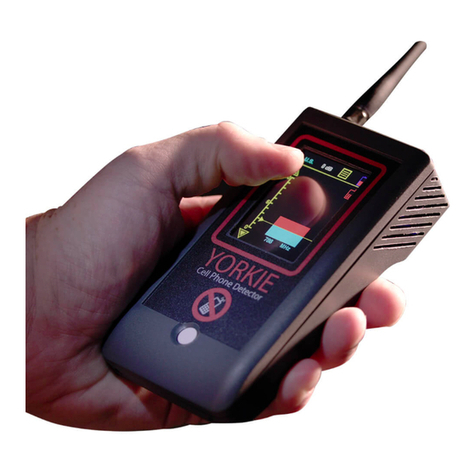
Berkeley Varitronics Systems
Berkeley Varitronics Systems YORKIE Quick start user guide

AGCO
AGCO HayBoss 700A installation manual

ESP
ESP MAGPRO-HD1 installation instructions
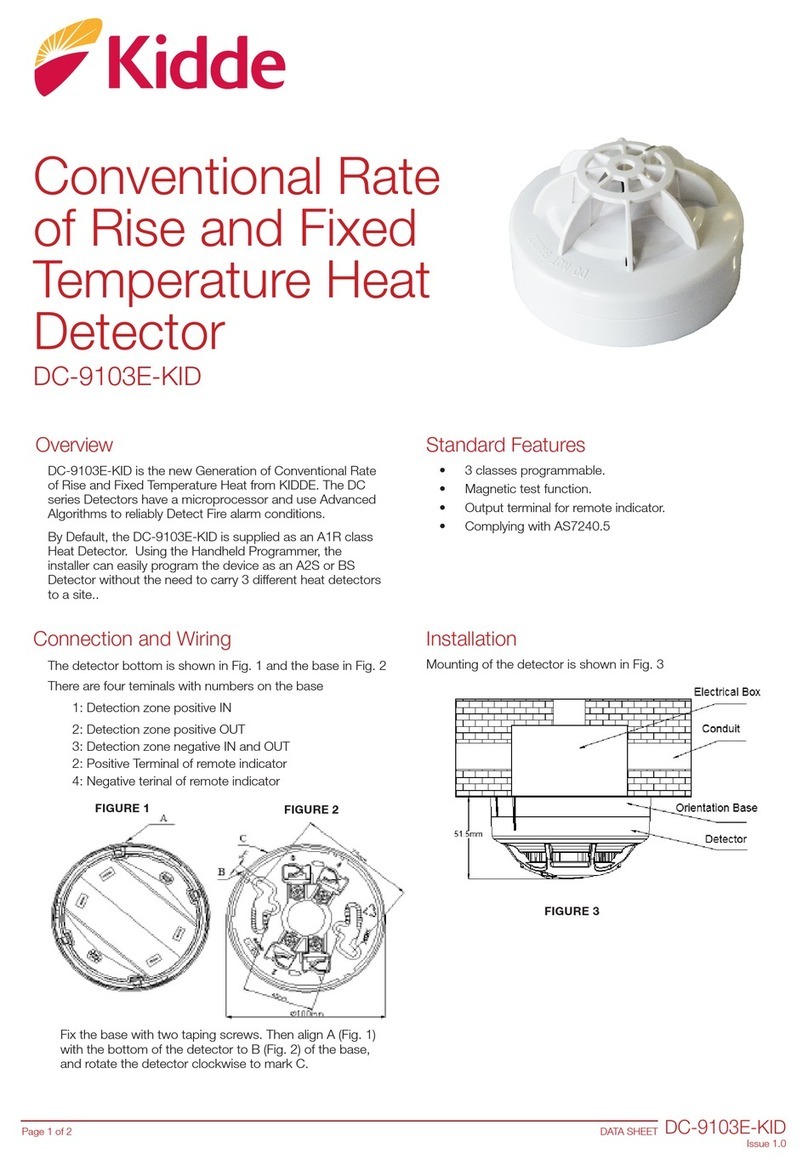
Kidde
Kidde DC-9103E-KID quick start guide
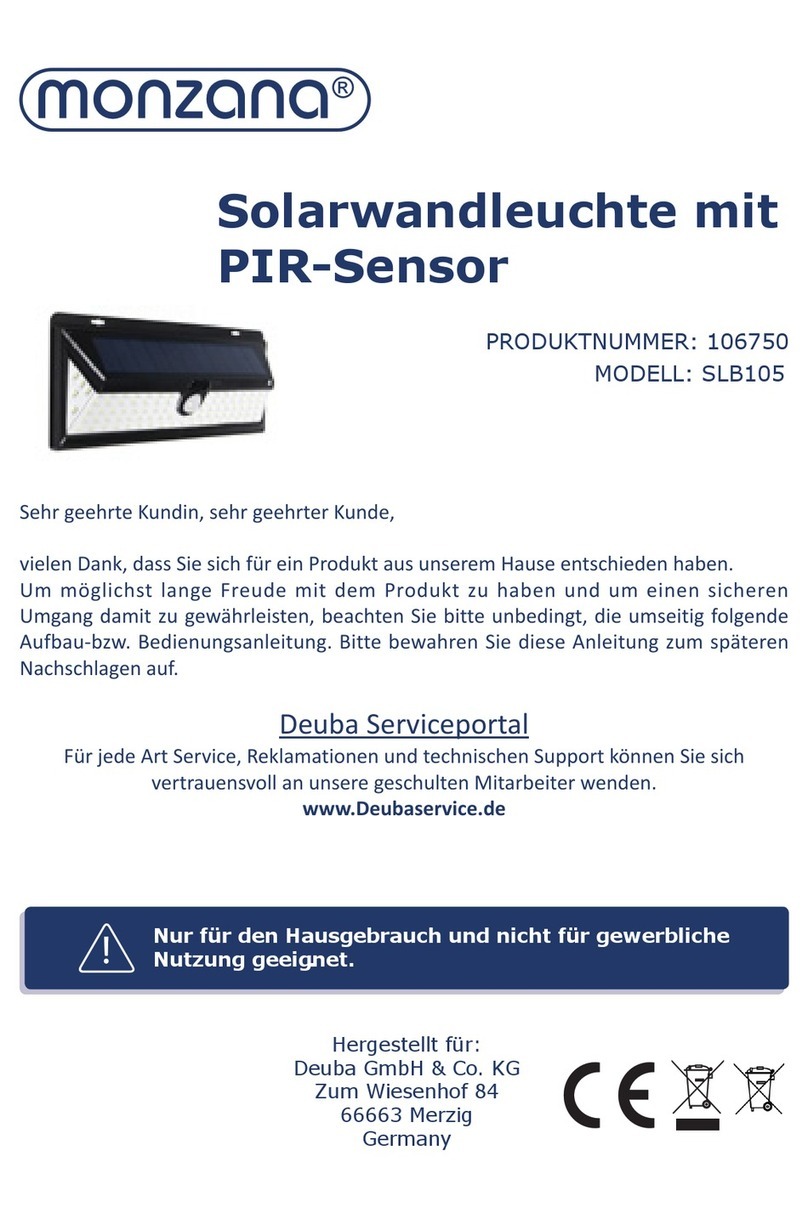
Monzana
Monzana SLB105 instructions

RKI Instruments
RKI Instruments 65-2494RK Operator's manual



